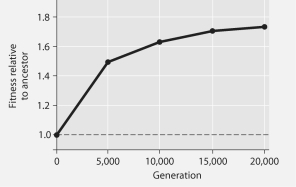The following questions refer to Figure 27.1 below, which is the same as Figure 27.10 in the textbook.
In this 8-year experiment, 12 populations of E. coli, each begun from a single cell, were grown in low-glucose conditions for 20,000 generations. Each culture was introduced to fresh growth medium every 24 hours. Occasionally, samples were removed from the populations, and their fitness in low-glucose conditions was tested against that of members sampled from the ancestral (common ancestor) E. coli population.

Figure 27.1
-If it occurs in the absence of any other type of adaptation listed here, which of these is least reasonable in terms of promoting bacterial survival over evolutionary time in a low-glucose environment?
Definitions:
Specialized Functions
Specific tasks or roles that certain organs, tissues, or cells in an organism are adapted to perform.
Differentiation
The process by which cells or tissues undergo a change toward a more specialized form or function, often seen in development.
Immune System
The body's defense mechanism against foreign substances and pathogens.
ERT Method
A technique used in various fields, such as geophysics and medicine, standing for Electrical Resistivity Tomography, which images subsurface structures.
Q13: Mycoplasmas are bacteria that lack cell walls.
Q16: Rank the following from most general to
Q18: The fruit contains an air bubble.<br>A)animal skin,
Q22: What is the most probable explanation for
Q22: Races of humans are unlikely to evolve
Q34: The thermoacidophile, Sulfolobus acidocaldarius lacks peptidoglycan. What
Q38: If the curve shifts to the left
Q59: You are given the task of designing
Q79: Which of these paired fungal structures are
Q82: The reason that paralogous genes can diverge